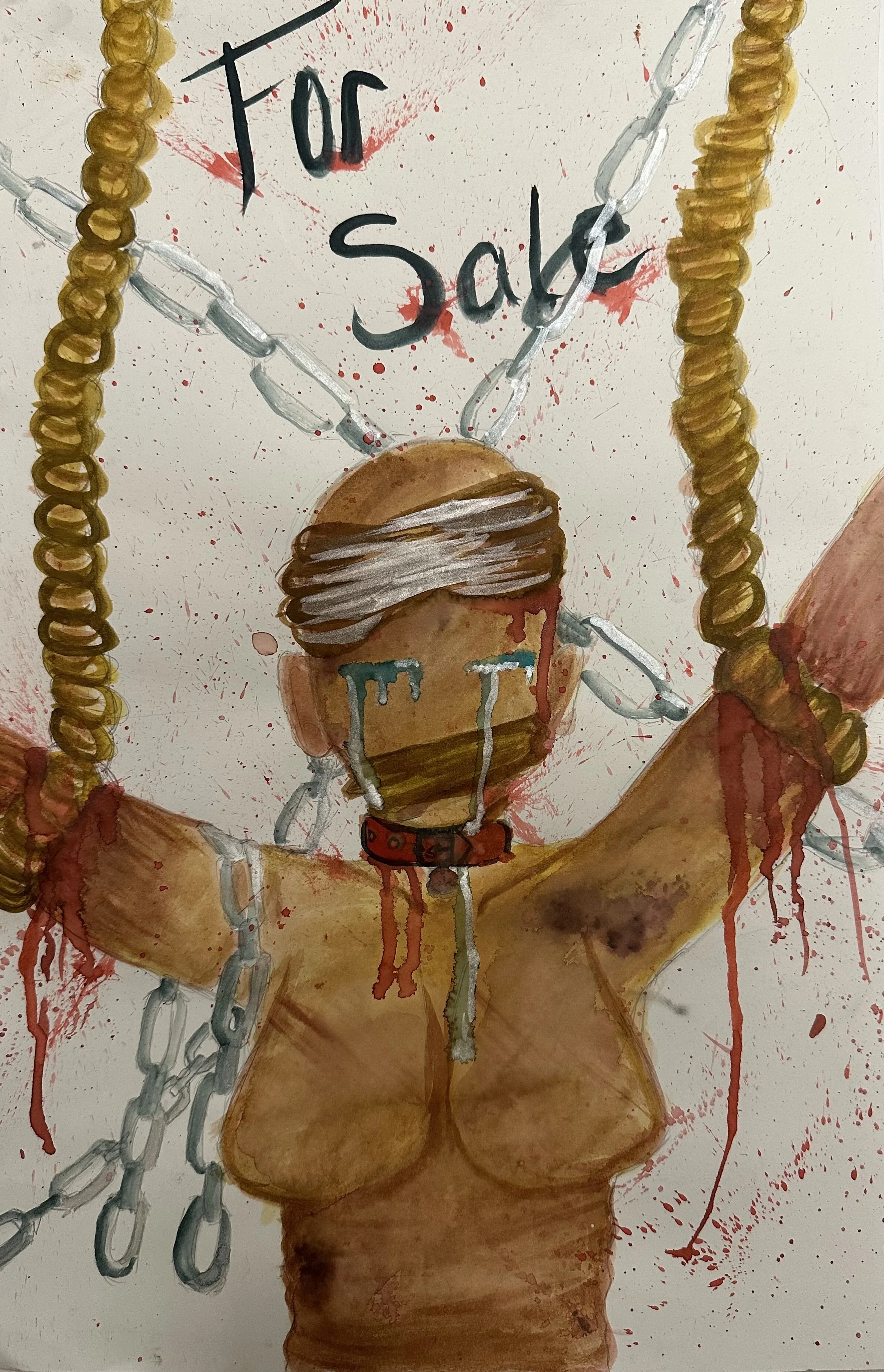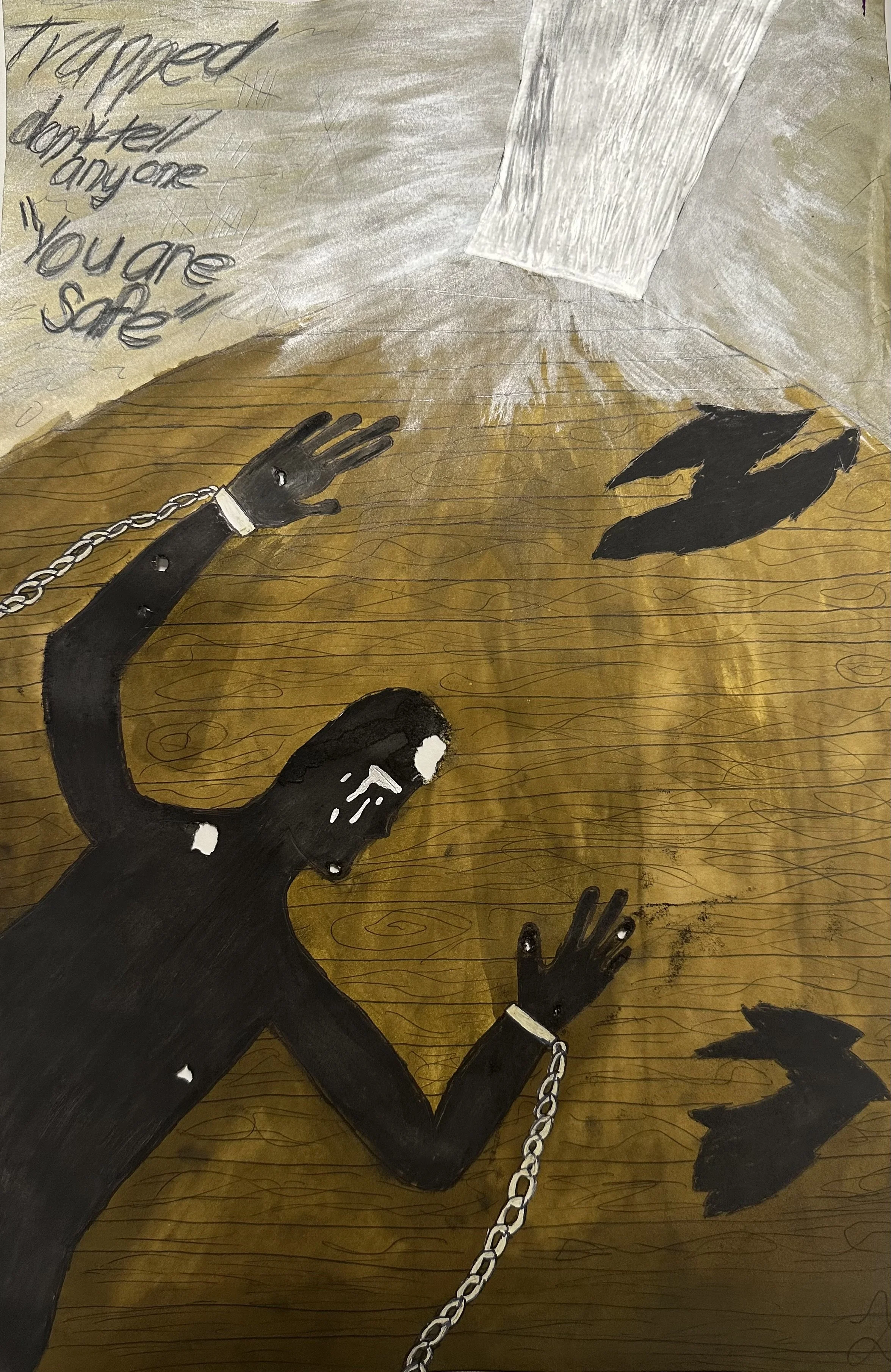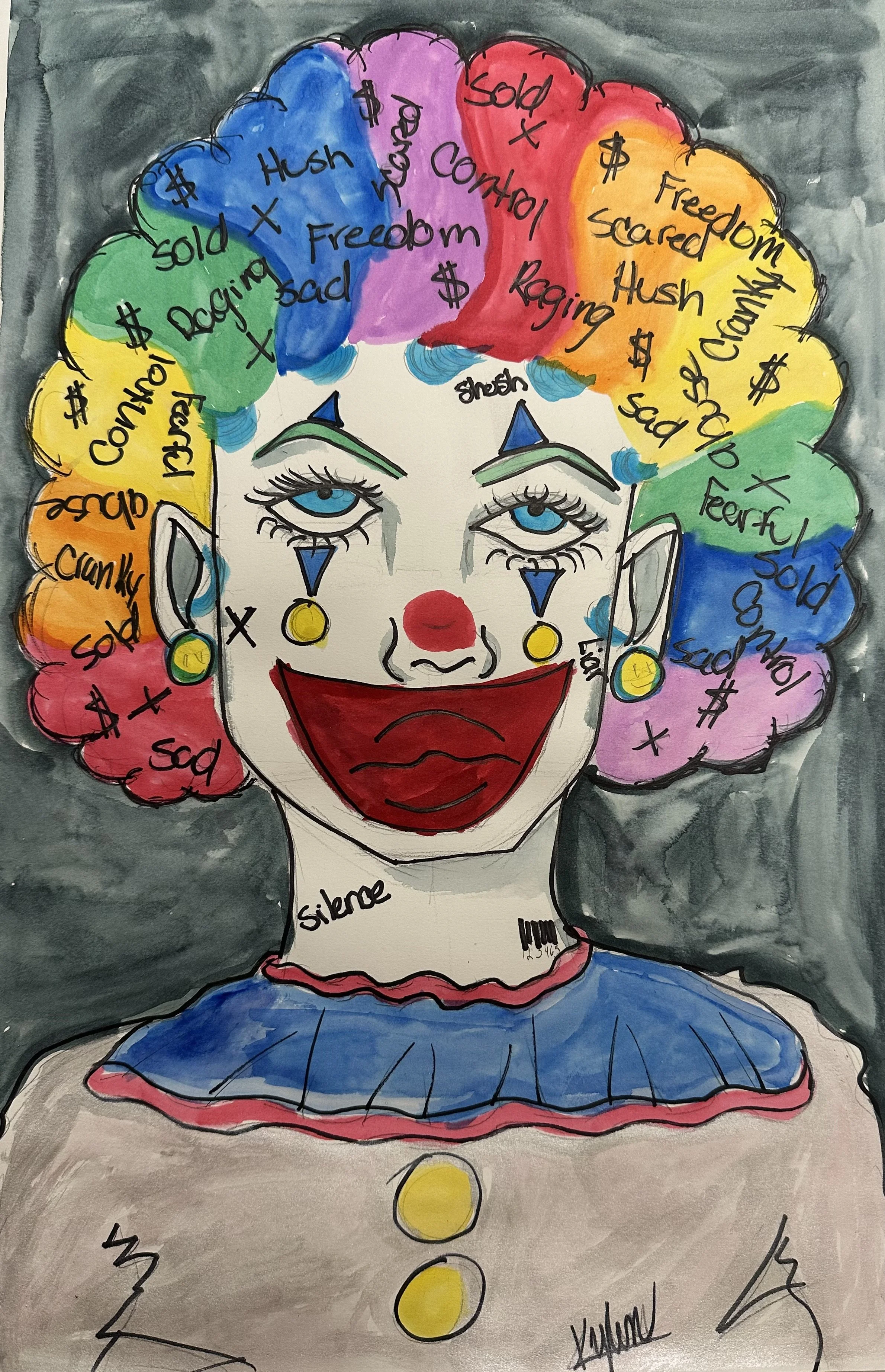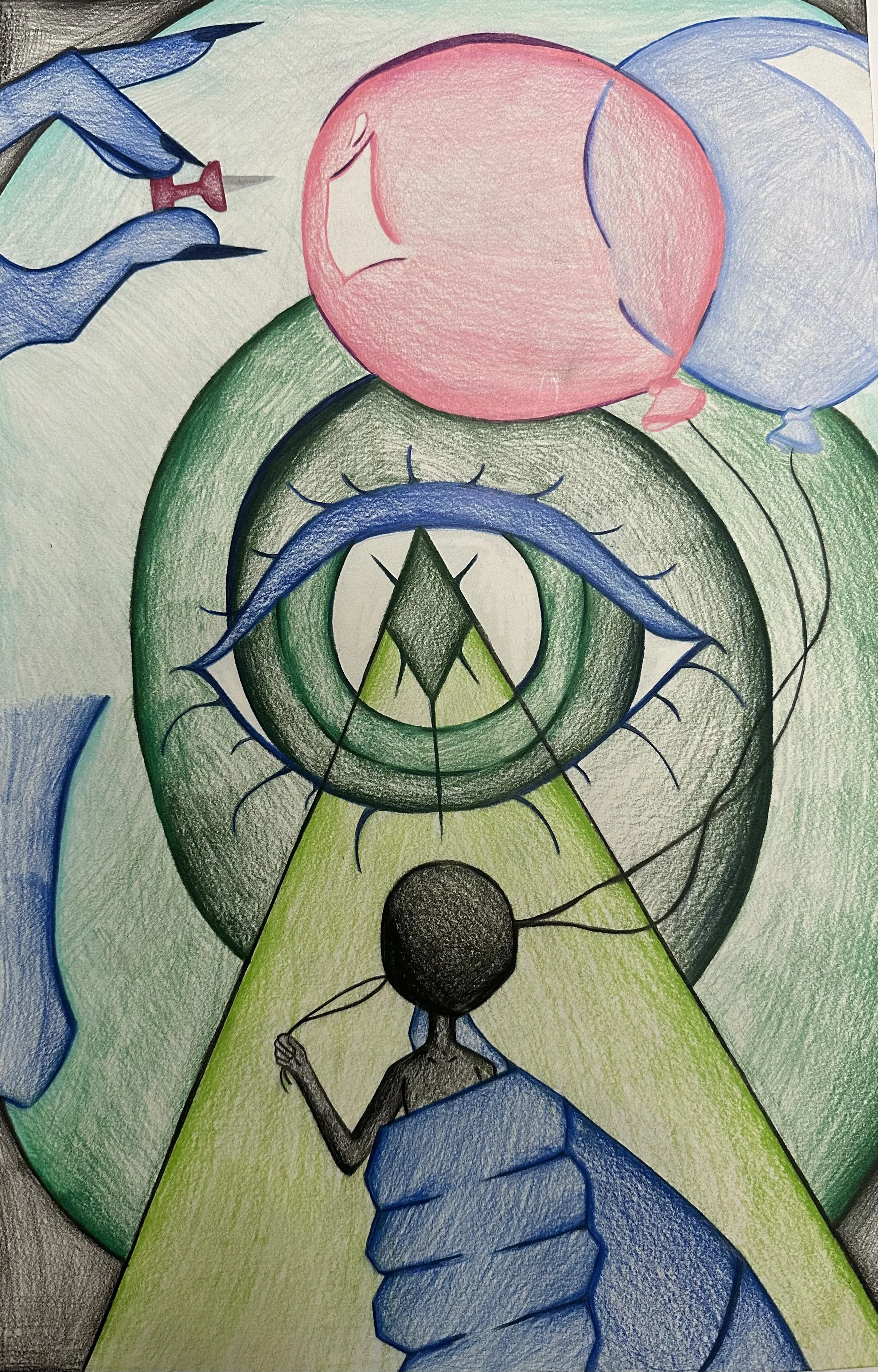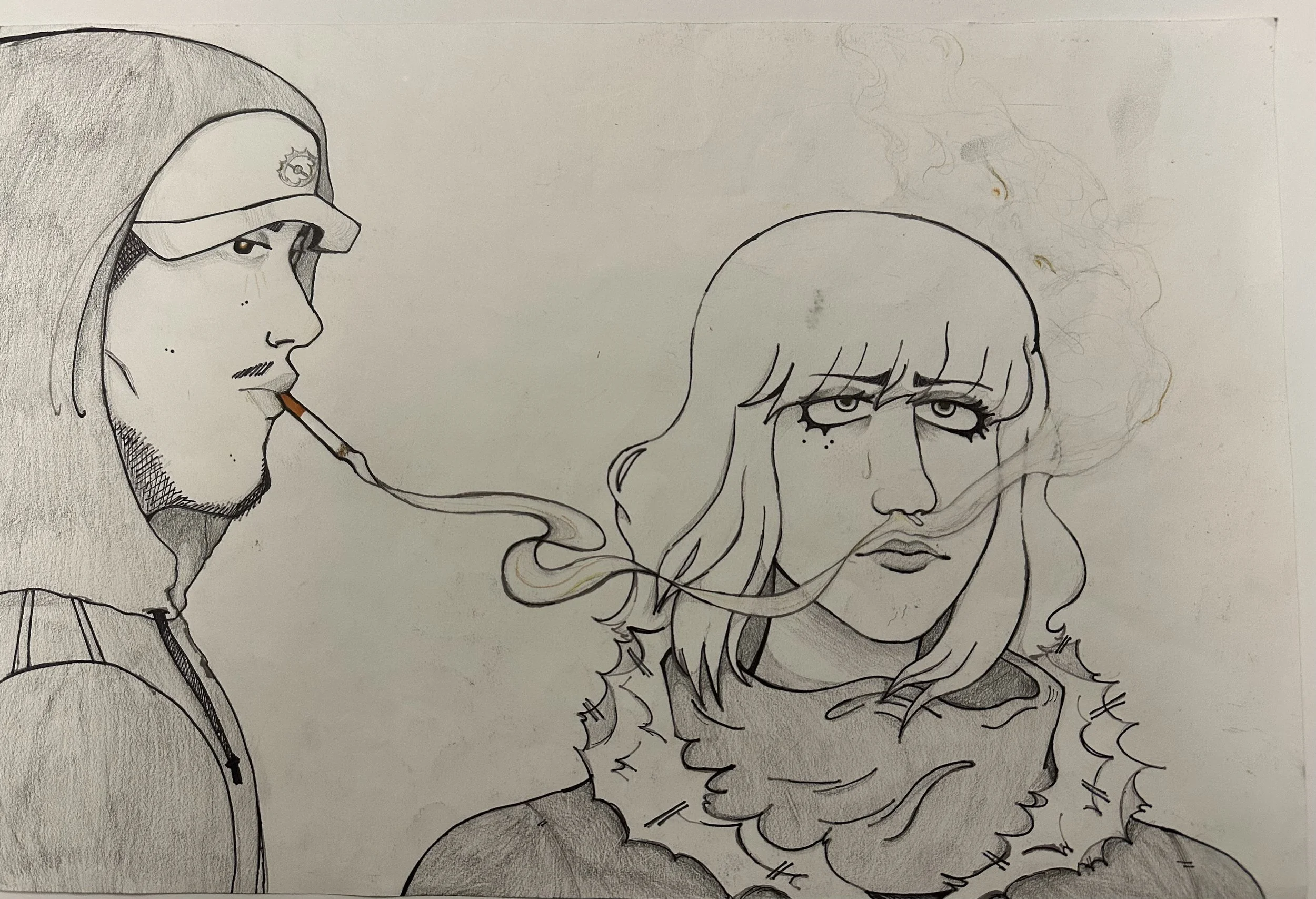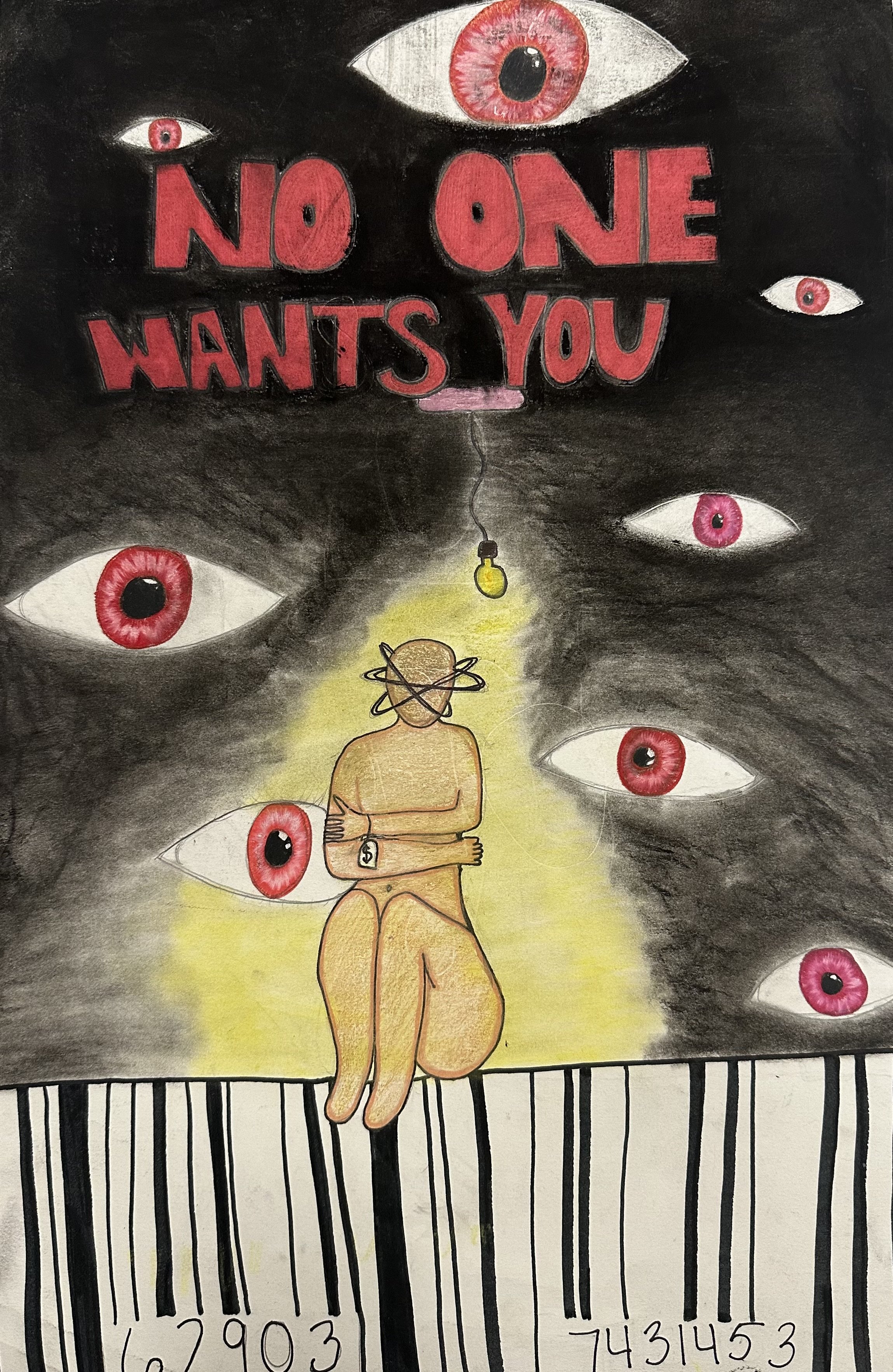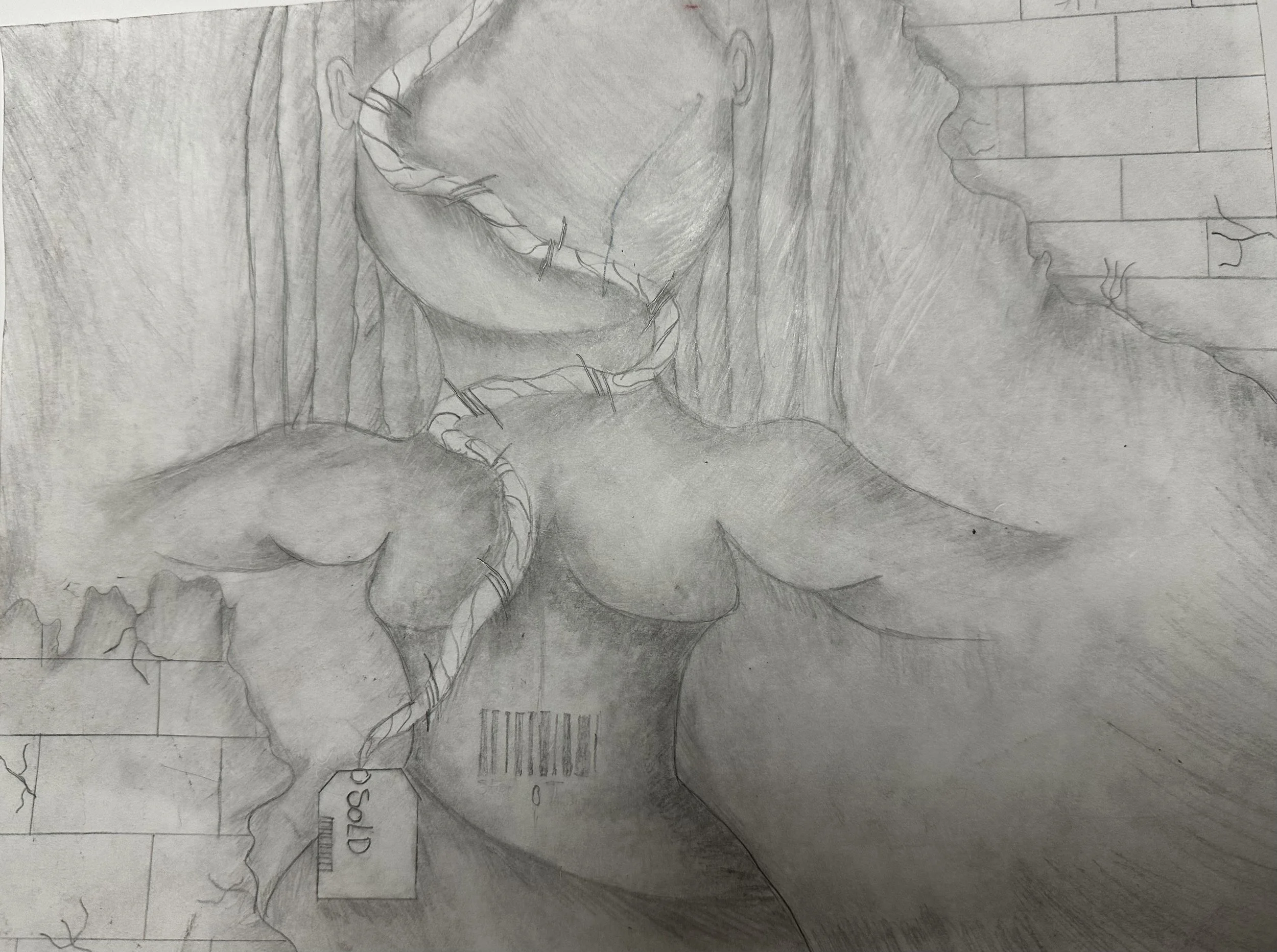5th Annual High School
Poetry Slam & Art Competition
Are you a high school student who loves to create art or write poetry/spoken word? Are you a high school teacher who wants to encourage your students’ creativity? Do you like to use your creative voice to make a difference and bring awareness to important issues? If so, please consider submitting a piece of art or poetry/spoken word for our competition!
Email traffickingconference@gmail.com with any questions.
Downloadable Flyer:
Congratulations to the winners!
Art Grand Prize Winner: Nijah N.
Art Runner-Up Winner: Sheymarie O. A.
Poetry Grand Prize Winner: Gracelyn V. - "Your Eyes"
Poetry Runner-Up Winner: Lori W. - "Black Mail, Favors, and Owning"
2023 Art Finalists
Make sure to vote for your favorite art piece HERE. Open voting is from November 1-December 31, so feel free to share these links with others!
Lexam A. - Grade 12; Toledo, Ohio
“Desperation; a person chained at the wrists lying on the floor a distance from the open door. Floor with a couple of holes, tally marks and writing on the walls: "trapped", "don't tell anyone", "you are safe". A lot/most people who have experienced human trafficking feel like they are held back by something (reason for the chains on wrists in piece) while they are staring right at the exit, they feel trapped. They are usually told "you are safe" and/or "don't tell anyone" which contributes to why it's under reported when it shouldn't be. Tally marks are daytime counters. Squiggles on the wall could mean either more writing or self harm. Holes on the person and in the floor represent physical and emotional abuse. Tears are the mental toll that this takes on a person. The artwork surrounding this topic inspired me and with what I know about human trafficking, this is what I drew.” - Lexam
Lacey B. - Grade 9; Toledo, Ohio
“The open door embodies our collective failure as citizens to close the door of human trafficking. Highlighting our inability to shield vulnerable individuals. The absence of facial features serves as a reminder that this could be anyone regardless of identity or background. The hand positioned at the bottom uncovers the harsh reality that women and teenage girls are sometimes forced into becoming accomplices of horrible people and drawing in victims of all ages. Throughout this piece, the harsh truths of this issue should hopefully urge viewers to recognize the urgency of closing the door on human exploitation.” - Lacey
Kylen G. - Grade 9; Toledo, Ohio
“What inspired me to do this piece were clowns and the Joker. Before the Joker became the Joker, he was a normal person. He went through a lot as a child, but no one listened to him so he became a villain. I thought about a clown because when you tell someone something from the heart and they don't listen you feel embarrassed like a clown. I thought this may be how victims of human trafficking may feel; like no one is listening so victims are embarrassed to tell.” - Kylen
Nijah N. - Grade 9; Toledo, Ohio
“I created this piece with a story in mind. This girl has been a victim of human trafficking for most of her life. She tried to escape the tightly wrapped ropes that are on her arms causing them to bleed. She is crying from the pain, abandonment and isolation that she has experienced as a result of her parents selling her. The traffickers would beat her every time she tried to escape. They would use chains on her and keep her in place. They used the bandages to muffle her screams and cover her serious wounds.” - Nijah
Sheymarie O. A. - Grade 9; Toledo, Ohio
“I created this artwork while considering the way the victims must feel. I painted the background black to portray darkness and sadness. I chose the color red for the evil the people commit. The bruises are for the abuse that the children and women face.” - Sheymarie
Jeteara R. - Grade 12; Toledo, Ohio
“This piece shows a victim of human trafficking and their innocence being taken under control by another individual. Innocence is represented by the balloons. The swirl that surrounds the whole piece represents control within the pin in the hand of the perpetrator while threatening to eventually burst and take away the victim's purity. Overall, I wanted this piece to portray that anyone can be a victim of human trafficking, hence the silhouette signifying the amount of manipulation and control that is involved.” - Jeteara
Judith R. - Grade 12; Toledo, Ohio
“This piece represents the fear and paranoia I feel when a stranger looks at me for too long when I walk alone. I feel as if I am not too far from a trap when a man even stands or walks behind me. The cigarette smell is fear inducing for the girl in the photo since she knows someone is near, but doesn't know if it's paranoia or genuine gut instinct. The eyes the cigarette smoke has stands for the way that the girl feels. She feels watched after she passed by the man. The bear trap on his hat implies that he is a trap not to be trusted. Is it a true moment of life or death or is it just fear? That is what I feel often. The fear of being pursued and being taken.” - Judith
Brooklynn S. - Grade 11; Toledo, Ohio
“I was inspired to create this piece to help deepen the impact and emotion regarding human trafficking. I wrote the words ‘No one wants you’ big, red, and bold to really pull the words from the piece and to make them sink in more. The eyes on the drawing represent the body being showcased without permission. The dark room with only one light signifies that in that moment they are alone. The price tag represents feeling like their body has a price on it. I used a lot of red because it is an impactful color that brings out emotion sometimes representing the devil.” - Brooklynn
Kaiden S. - Grade 9; Toledo, Ohio
“I made this art piece to show a visual representation of human trafficking. The hands are supposed to symbolize the traffickers (assaulters) and how they take advantage of young and vulnerable people, especially girls. While the girl in the middle represents the victim grieving her situation.” - Kaiden
Chelienys V. - Grade 9; Toledo, Ohio
“The artwork doesn't have a face because no one is looking at her face, they are looking at her body. They see her as a thing, not a human being. The walls are for the ugly room the traffickers put them in. The tag to let others know she is sold and no one can buy her. The chain ensures she doesn't escape.” - Chelienys
Gracelyn V. - Grade 9; Monclova, Ohio
”My art was inspired by various lines within my original poem ‘Your Eyes’ (see below in Poetry Finalists section). These lines include, ‘I looked into your eyes, they were a beautiful pale blue. Your pale blue irises spoke of pain of various kinds…You always spoke wistfully of birds...The single broken tooth…The deep cuts and scarring on your thin body…Many say that the eyes are windows to ones soul. They were right. I can see it. I can see it through your eyes. Your soul has been battered. Like a mirror, it has shattered.’ My art is an eye created from charcoal and watercolor paint. The iris of the eye is made from both charcoal and watercolor paint. I also used charcoal to draw a bird, a mouth, a hand, and human ribs, heart, and lungs. I drew the bird because it was implied that the victim in my poem stated that she yearned for the freedom that a bird has. I drew a mouth to represent the victim's broken tooth. I drew a hand to show the tattoo/branding mark on the victim's wrist. I drew the human ribs, heart, and lungs to symbolize the skinny and underweight body of the victim in my poem. I wanted to show the idiom ‘you look like your just skin and bones’ in a more literal sense. My reasoning for using both charcoal and watercolor paint for the iris is that I wanted to show how the victim in my poem loses the light in her eyes. The charcoal made the eyes look duller and darker, while the watercolor paint allowed me to still show that the iris is blue. The pupil of the eye is a broken mirror. The reflection of the broken mirror shows a woman with a hand wrapped around her mouth, like the hand is forcing her into silence. The mirror, woman, and hand are all drawn with charcoal. However, I used watercolor paint to paint the woman’s iris in her single visible eye. All of this is because I wanted to show the memories that the victim in my poem has from her time in captivity, while also connecting back to my poem when it says that the eyes can be considered windows to a person's soul.” - Gracelyn
2023 Poetry Finalists
Make sure to vote for your favorite poetry piece HERE. Open voting is from November 1-December 31, so feel free to share these links with others!
Denejah B. - Grade 10; Toledo, Ohio
CLICK HERE TO READ DENEJAH’S POEM, “BETRAYED”
CLICK HERE TO READ DENEJAH’S POEM, “CREEP”
These poems were inspired by Fearless Writers. The students wanted to learn more about human trafficking and picked human trafficking as their social justice issue to write about. Fearless Writers had guest writers come and write with the students, including Anna Schramm and Celia Williamson from the Human Trafficking and Social Justice Institute. They also looked to the series of books that have been published from the original research in Reviving Ophelia: Saving the Selves of Adolescent Girls (Phiper, 1994). This piece illustrates the fears and myths surrounding human trafficking as well as self-esteem and healthy and unhealthy relationships which also inform vulnerability to being trafficked. The students of Fearless Writers were inspired by each other and through the various voices used as prompts for this writing. A special thanks to Arya Nair and Ayanna Jordon who assisted these writers in the pursuit of this award.Ke'ira D. - Grade 10; Toledo, Ohio
CLICK HERE TO READ KE’IRA’S POEM, “LOVE AND HATE”
This poem was inspired by Fearless Writers. The students wanted to learn more about human trafficking and picked human trafficking as their social justice issue to write about. Fearless Writers had guest writers come and write with the students, including Anna Schramm and Celia Williamson from the Human Trafficking and Social Justice Institute. They also looked to the series of books that have been published from the original research in Reviving Ophelia: Saving the Selves of Adolescent Girls (Phiper, 1994). This piece illustrates the fears and myths surrounding human trafficking as well as self-esteem and healthy and unhealthy relationships which also inform vulnerability to being trafficked. The students of Fearless Writers were inspired by each other and through the various voices used as prompts for this writing. A special thanks to Arya Nair and Ayanna Jordon who assisted these writers in the pursuit of this award.Te'Corea D. - Grade 10; Toledo, Ohio
CLICK HERE TO READ TE’COREA’S POEM, “SIDE BY SIDE”
This poem was inspired by Fearless Writers. The students wanted to learn more about human trafficking and picked human trafficking as their social justice issue to write about. Fearless Writers had guest writers come and write with the students, including Anna Schramm and Celia Williamson from the Human Trafficking and Social Justice Institute. They also looked to the series of books that have been published from the original research in Reviving Ophelia: Saving the Selves of Adolescent Girls (Phiper, 1994). This piece illustrates the fears and myths surrounding human trafficking as well as self-esteem and healthy and unhealthy relationships which also inform vulnerability to being trafficked. The students of Fearless Writers were inspired by each other and through the various voices used as prompts for this writing. A special thanks to Arya Nair and Ayanna Jordon who assisted these writers in the pursuit of this award.My'Lah H. - Grade 12; Toledo, Ohio
CLICK HERE TO READ MY’LAH’S POEM, “SECRET SCARS”
This poem was inspired by Fearless Writers. The students wanted to learn more about human trafficking and picked human trafficking as their social justice issue to write about. Fearless Writers had guest writers come and write with the students, including Anna Schramm and Celia Williamson from the Human Trafficking and Social Justice Institute. They also looked to the series of books that have been published from the original research in Reviving Ophelia: Saving the Selves of Adolescent Girls (Phiper, 1994). This piece illustrates the fears and myths surrounding human trafficking as well as self-esteem and healthy and unhealthy relationships which also inform vulnerability to being trafficked. The students of Fearless Writers were inspired by each other and through the various voices used as prompts for this writing. A special thanks to Arya Nair and Ayanna Jordon who assisted these writers in the pursuit of this award.Amanda K. - Grade 12; Toledo, Ohio
CLICK HERE TO READ AMANDA’S POEM, “THE QUESTION IS WHY?”
This poem was inspired by Fearless Writers. The students wanted to learn more about human trafficking and picked human trafficking as their social justice issue to write about. Fearless Writers had guest writers come and write with the students, including Anna Schramm and Celia Williamson from the Human Trafficking and Social Justice Institute. They also looked to the series of books that have been published from the original research in Reviving Ophelia: Saving the Selves of Adolescent Girls (Phiper, 1994). This piece illustrates the fears and myths surrounding human trafficking as well as self-esteem and healthy and unhealthy relationships which also inform vulnerability to being trafficked. The students of Fearless Writers were inspired by each other and through the various voices used as prompts for this writing. A special thanks to Arya Nair and Ayanna Jordon who assisted these writers in the pursuit of this award.Aniyah P. - Grade 12; Toledo, Ohio
CLICK HERE TO READ ANIYAH’S POEM, “DON’T LOOK FOR WHAT ISN’T THERE”
This poem was inspired by Fearless Writers. The students wanted to learn more about human trafficking and picked human trafficking as their social justice issue to write about. Fearless Writers had guest writers come and write with the students, including Anna Schramm and Celia Williamson from the Human Trafficking and Social Justice Institute. They also looked to the series of books that have been published from the original research in Reviving Ophelia: Saving the Selves of Adolescent Girls (Phiper, 1994). This piece illustrates the fears and myths surrounding human trafficking as well as self-esteem and healthy and unhealthy relationships which also inform vulnerability to being trafficked. The students of Fearless Writers were inspired by each other and through the various voices used as prompts for this writing. A special thanks to Arya Nair and Ayanna Jordon who assisted these writers in the pursuit of this award.Justice R. - Grade 10; Toledo, Ohio
CLICK HERE TO READ JUSTICE’S POEM, “JUSTICE?”
”This piece means a lot to me because I feel like justice is important.” - JusticeAnna S. - Grade 10; Toledo, Ohio
CLICK HERE TO READ ANNA’S POEM, “BOYS”
CLICK HERE TO READ ANNA’S POEM, “FAULT”
CLICK HERE TO READ ANNA’S POEM, “HIDEOUS”
CLICK HERE TO READ ANNA’S POEM, “IMPATIENT”
CLICK HERE TO READ ANNA’S POEM, “UNSPOKEN”
These poems were inspired by Fearless Writers. The students wanted to learn more about human trafficking and picked human trafficking as their social justice issue to write about. Fearless Writers had guest writers come and write with the students, including Anna Schramm and Celia Williamson from the Human Trafficking and Social Justice Institute. They also looked to the series of books that have been published from the original research in Reviving Ophelia: Saving the Selves of Adolescent Girls (Phiper, 1994). This piece illustrates the fears and myths surrounding human trafficking as well as self-esteem and healthy and unhealthy relationships which also inform vulnerability to being trafficked. The students of Fearless Writers were inspired by each other and through the various voices used as prompts for this writing. A special thanks to Arya Nair and Ayanna Jordon who assisted these writers in the pursuit of this award.Sydnee S. - Grade 10; Toledo, Ohio
CLICK HERE TO READ SYDNEE’S POEM, “BOND”
This poem was inspired by Fearless Writers. The students wanted to learn more about human trafficking and picked human trafficking as their social justice issue to write about. Fearless Writers had guest writers come and write with the students, including Anna Schramm and Celia Williamson from the Human Trafficking and Social Justice Institute. They also looked to the series of books that have been published from the original research in Reviving Ophelia: Saving the Selves of Adolescent Girls (Phiper, 1994). This piece illustrates the fears and myths surrounding human trafficking as well as self-esteem and healthy and unhealthy relationships which also inform vulnerability to being trafficked. The students of Fearless Writers were inspired by each other and through the various voices used as prompts for this writing. A special thanks to Arya Nair and Ayanna Jordon who assisted these writers in the pursuit of this award.Savana U. - Grade 12; Toledo, Ohio
CLICK HERE TO READ SAVANA’S POEM, “LOSING TIME”
CLICK HERE TO READ SAVANA’S POEM, “TRAFFICKED 2 MYTH”
CLICK HERE TO READ SAVANA’S POEM, “WHAT IS TRAFFICKING?”
CLICK HERE TO READ SAVANA’S POEM, “CHILD LABOR”
These poems were inspired by Fearless Writers. The students wanted to learn more about human trafficking and picked human trafficking as their social justice issue to write about. Fearless Writers had guest writers come and write with the students, including Anna Schramm and Celia Williamson from the Human Trafficking and Social Justice Institute. They also looked to the series of books that have been published from the original research in Reviving Ophelia: Saving the Selves of Adolescent Girls (Phiper, 1994). This piece illustrates the fears and myths surrounding human trafficking as well as self-esteem and healthy and unhealthy relationships which also inform vulnerability to being trafficked. The students of Fearless Writers were inspired by each other and through the various voices used as prompts for this writing. A special thanks to Arya Nair and Ayanna Jordon who assisted these writers in the pursuit of this award.Gracelyn V. - Grade 9; Monclova, Ohio
CLICK HERE TO READ GRACE’S POEM, “YOUR EYES”
”My poem titled ‘Your Eyes’ has a multitude of different meanings to me. For me, this poem means despair, pain, and exhaustion. Despair is shown when the victim of human trafficking in my poem loses the remaining light in their eyes. The light in one's eyes can be considered a metaphor for hope; hope the victim in my poem has lost. That is what despair is, the total loss of hope. Physical pain is shown when I describe the multitude of injuries that the victim in my poem has received by the hands of their capture. Exhaustion is shown when, instead of panicking or redirecting the conversation, the victim in my poem just stares and asks, “How did you know”. The victim in my poem is too tired to try and make up an excuse. I chose to base my poem off of these words because something as serious as human trafficking is most likely very traumatic for the victims. Many people in the world like to write off traumatic situations as “no big deal” or “something you can easily get over”, but this is false. The things that victims of human trafficking face are horrific, and will most likely affect the victims for the remainder of their lives. The after effects of human trafficking, such as a victim's mental state, is not talked about as much as it should be. Some people think that after a victim is saved, their life will go back to their original version of normal. Some will invalidate the trauma of victims. What I'm hoping my poem does for others is make them realize the severity of the situation, and think about how life altering it can be.” - GracelynLori W. - Grade 12; Toledo, Ohio
CLICK HERE TO READ LORI’S POEM, “STEPS”
CLICK HERE TO READ LORI’S POEM, “BLACK MAIL, FAVORS, AND OWNING”
CLICK HERE TO READ LORI’S POEM, “POV HUMAN TRAFFICKING SCENE”
These poems were inspired by Fearless Writers. The students wanted to learn more about human trafficking and picked human trafficking as their social justice issue to write about. Fearless Writers had guest writers come and write with the students, including Anna Schramm and Celia Williamson from the Human Trafficking and Social Justice Institute. They also looked to the series of books that have been published from the original research in Reviving Ophelia: Saving the Selves of Adolescent Girls (Phiper, 1994). This piece illustrates the fears and myths surrounding human trafficking as well as self-esteem and healthy and unhealthy relationships which also inform vulnerability to being trafficked. The students of Fearless Writers were inspired by each other and through the various voices used as prompts for this writing. A special thanks to Arya Nair and Ayanna Jordon who assisted these writers in the pursuit of this award.
Parameters
Poetry:
No longer than 5 minutes
No inappropriate language
Art:
Can use various mediums: photography, acrylic paint, watercolor paint, colored pencils, ink, chalk, collage, mixed media, digital, etc.
No inappropriate language
Topics
The art or poetry/spoken word must answer one of the following questions related to labor or sex trafficking:
(CLICK HERE for in-depth answers to these questions)
What is human trafficking?
Who are the victims?
Who are the traffickers and buyers?
Why does it happen?
How are vulnerable people/victims recruited?
Where are victims recruited?
Where are places victims are sold?
What are the warning signs?
Where can victims go to get help/Where can you go to get help?
How can you reduce the risk of trafficking/How can you be safe?
How can you be an upstander (a bystander who steps up to do something)?
*Please make sure that you have done your research so your art or poetry/spoken word accurately reflects this topic.
How to Submit
Poetry:
Type out your completed poem/spoken word piece
Email the document to utpoetryslam@gmail.com along with the follow information:
First & Last Name
Grade & School
City & State
Answer to the question “What inspired you to write this piece?” OR “What does this piece mean to you?”
You must submit the email no later than Friday, October 27th by 11:59 pm ET. (Please note, teachers are able to submit the entries for their students and can submit multiple entries in one email.)
The Poetry Committee will review each piece of poetry/spoken word and will let each artist know if their piece was selected for the competition by Tuesday, October 31st.
Art:
Take a picture of your completed artwork:
Artwork must be centered in the picture
Artwork must take up as much of the picture as possible without cutting anything off
Artwork must be in front of a neutral background with no distracting colors or objects in the background
Picture must be taken in the same orientation of the artwork (landscape/horizontal or portrait/vertical)
Picture must be clear and in focus
Email the picture to utartcompetition@gmail.com along with the follow information:
First & Last Name
Grade & School
City & State
Answer to the question “What inspired you to create this piece?” OR “What does this piece mean to you?”
You must submit the email no later than Friday, October 27th by 11:59 pm ET. (Please note, teachers are able to submit entries for their students and can submit multiple entries in one email.)
The Art Committee will review each piece of artwork and will let each artist know if their piece was selected for the competition by Tuesday, October 31st.
Competition & Awards
Each piece of poetry and art selected by the Committees will be showcased on our website as part of the competition.
Open voting will begin on November 1st and will close on December 31st. During this period, students, teachers, family, friends, and community members will be able to vote on their favorite poem and favorite art piece.
A panel of judges will also be reviewing and scoring each poem and art piece.
For the poetry pieces, judges will provide scores based on these criteria (up to 10 points in each category): Accuracy/Substance of how accurately it portrays human trafficking, Poetic Expression of the piece, and Originality of the piece.
For the art pieces, judges will provide scores based on these criteria (up to 10 points in each category): Accuracy/Substance of how accurately it portrays human trafficking, Aesthetic Quality of the piece, and Originality of the artwork.
The judges scores will be combined with the popular votes from the open voting to determine the winners in each category (poetry & art). Winners will be announced on our website, social media, and via email on Friday, January 5, 2024.
The Grand Prize winner in each category (poetry & art) will receive a $250 Amazon gift card. The Runner Up in each category (poetry & art) will receive a $50 Amazon gift card.
Looking Ahead…
If you are wanting to pursue your passion for writing and/or art in your future, you may be interested in learning more about The University of Toledo’s English and Art programs for your college degree. Learn more at their websites below:
The University of Toledo’s English Department: https://www.utoledo.edu/al/english/
The University of Toledo’s Art Department: https://www.utoledo.edu/al/svpa/art/



